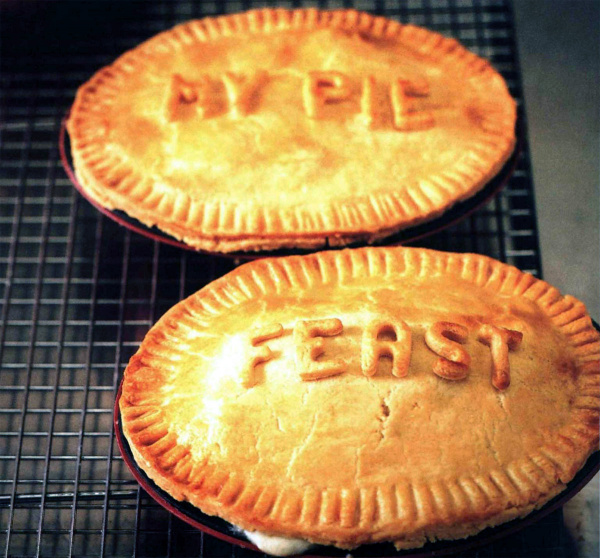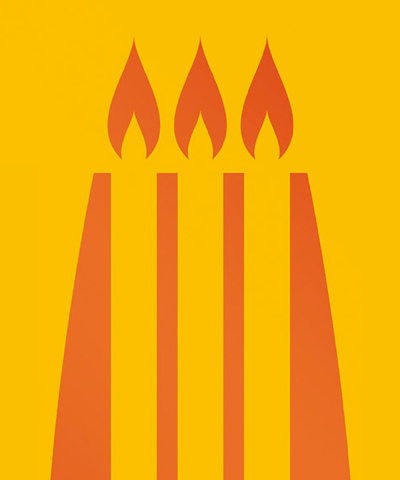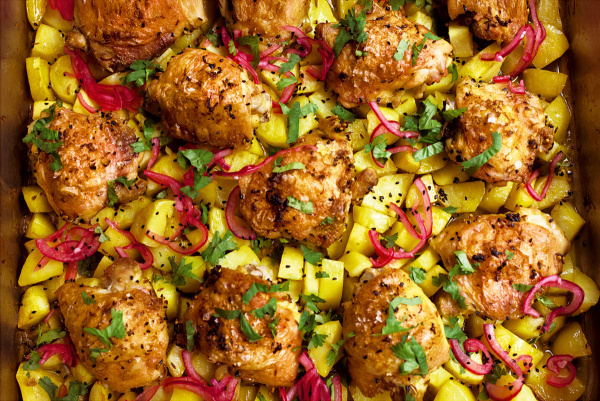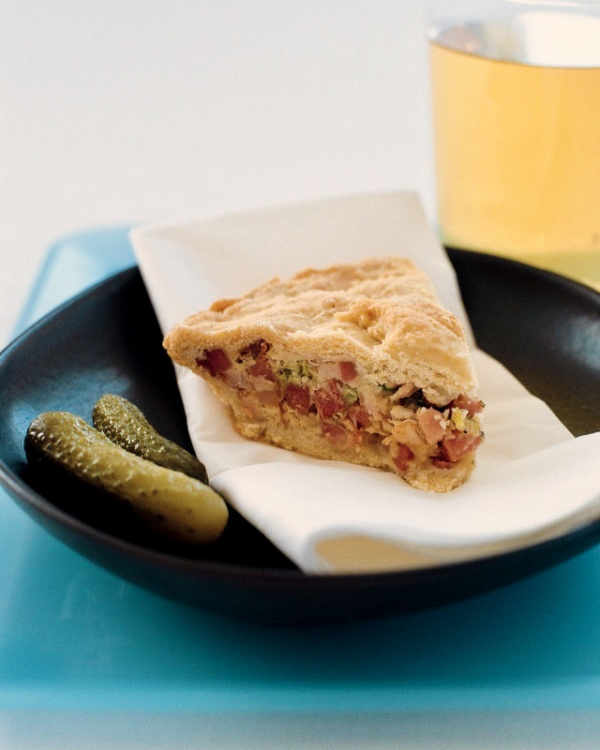Chicken and Ham Pies
by Nigella. Featured in FEASTIntroduction
I loved making these pies for my children when they were little, not that it makes me any less happy to make them now. I think it’s safe to say that — for most of us — a pie is always a blessing. And I know that the very many steps of the recipe that follows might seem to indicate that these are difficult, but they're really not. Sometimes a short recipe makes it look simpler, when more detailed instructions actually make it simpler! Yes, there is a bit of fiddliness involved, but nothing actually tricksy. I wouldn’t advise making them when you’re in a rush, but they are a real treat, and even such natural ingrates as children will appreciate them!
While you could cut out the pastry-making and use ready-made shortcrust, I promise you the pastry below is fabulously well-behaved: the freezing of the cubed butter and flour for ten minutes first makes it pliable, elastic and robust, though tender to the bite. I learned this from Cookwise by the scientist-cum-cookery-teacher Shirley O. Corriher decades ago, and it banished my fear of making pastry forever.
You’ll need little letter-cutters if you want to decorate as I have (unless you are clever enough to cut them out freehand) but the little pies taste just as good, of course, without that!
And please read the Additional Information section at the end of the recipe before proceeding.
I loved making these pies for my children when they were little, not that it makes me any less happy to make them now. I think it’s safe to say that — for most of us — a pie is always a blessing. And I know that the very many steps of the recipe that follows might seem to indicate that these are difficult, but they're really not. Sometimes a short recipe makes it look simpler, when more detailed instructions actually make it simpler! Yes, there is a bit of fiddliness involved, but nothing actually tricksy. I wouldn’t advise making them when you’re in a rush, but they are a real treat, and even such natural ingrates as children will appreciate them!
While you could cut out the pastry-making and use ready-made shortcrust, I promise you the pastry below is fabulously well-behaved: the freezing of the cubed butter and flour for ten minutes first makes it pliable, elastic and robust, though tender to the bite. I learned this from Cookwise by the scientist-cum-cookery-teacher Shirley O. Corriher decades ago, and it banished my fear of making pastry forever.
You’ll need little letter-cutters if you want to decorate as I have (unless you are clever enough to cut them out freehand) but the little pies taste just as good, of course, without that!
And please read the Additional Information section at the end of the recipe before proceeding.

Share or save this
Ingredients
Serves: 4
FOR THE PASTRY
- 450 grams plain flour
- 225 grams cold unsalted butter
- 3 eggs
FOR THE FILLING
- 60 grams butter
- 50 grams plain flour
- 1 chicken stock cube or 1½ tablespoons concentrated chicken bouillon
- 625 millilitres full fat milk
- 150 grams frozen peas
- 250 grams diced cold cooked chicken
- 125 grams diced cold cooked ham (or 375g / 3 cups chicken if not using ham)
FOR THE PASTRY
- 3 cups all-purpose flour
- 2 sticks cold unsalted butter
- 3 eggs
FOR THE FILLING
- 4 tablespoons butter
- ⅓ cup all-purpose flour
- 1 chicken broth cube or 1½ tablespoons concentrated chicken bouillon
- 2½ cups whole milk
- 1 cup frozen peas
- 2 cups diced cold cooked chicken
- 1 cup diced cold cooked ham (or 375g / 3 cups chicken if not using ham)
Method
- Put the flour into a bowl — a shallow tray of some kind might be best — and add the butter diced into cubes. Give a shake, gently, then put into the freezer for 10 minutes. It's this that makes the pastry so pliable as you roll it and so melting as you eat it, so don't miss out this stage. At the same time, beat 2 of the eggs with a tablespoon of iced water and stick in the fridge.
- Tip the chilled flour and butter into a food processor, and then pulse the mixture until it resembles fine, dry rubble. Feed the chilled beaten eggs down the shoot of the processor while it is running, adding a little at a time until it begins to form a ball. You want to stop just as the ball is beginning to cohere and the dough clumps around the blades; don't carry on beyond that point, but be prepared to add some iced water down the chute if you need more liquid to bring this about. When making the pastry, a free-standing mixer fitted with the flat paddle will do the job just as well, only slightly more slowly. And I find you need less liquid when using the processer rather than the mixer.
- Tip out on to the work surface and form into four discs, making two slightly bigger than the remaining two. (These will make the base and top of the pies.) Wrap each pastry disc in clingfilm and let rest in the fridge while you make the pie filling.
- So: melt the butter in a thick-bottomed saucepan over a low heat, then whisk in the flour and crumbled stock cube; if you're using the liquid bouillon concentrate you can add it after the milk. Off the heat, add the milk a little at a time, whisking to a smooth paste as you go. When all the milk is incorporated, put back on the heat, turn up to medium to high — but don't let it actually boil fiercely — and stir or whisk constantly for a few minutes to get rid of the starch in the flour and to make a really thick sauce. Do not stop stirring at any time. You may want to turn the heat down, though. Pour the thick white sauce into a bowl and cover with dampened baking parchment or press on clingfilm to stop a skin forming, if you aren't proceeding to assemble the pies straightaway.
- When you're about ready to get baking, slip a metal sheet in the oven and pre-heat it to 200°C/180°C/400°F. Put the peas into a sieve, and pour a kettleful of freshly boiled water over them, shaking off the excess water. Or you can sit the peas in warm water while you make the sauce: it all depends on your timetable
- Dice or shred the chicken or chicken and ham and mix the thawed peas (sweetcorn if using — see additional info below), chicken and ham into the cooled white sauce. I always make the sauce, like the pastry, in advance which is why it's always cooled for me, but if you want to go straight through in one run, the sauce will still be warm, obviously.
- It's easiest to do two pies at a time. Roll out one of the bigger discs of pastry on a floured surface to a size big enough to line the bases and sides of two oval pie dishes (capacity about 300ml, 14cm at their longest point, 4cm deep). Leave a generous lip of pastry hanging over the edge of each one.
- Spoon half the filling into each of the two dough-lined pie dishes, and roll out one of the smaller discs of pastry for the two lids. Dampen the pastry edges of the pies with some water and lay the lids on top. Trim the excess pastry from around the sides with a knife, and seal the edges with the prongs of a fork. Decorate with leftover dough.
- Cut out any shapes you like for the top: I most often use little letter cutters either to spell out my children's names or to let them write what they want, within reason. Just dampen the underside of each letter or cut-out and sit it, pressing firmly but gently, on the top of the pie. Beat the remaining egg for the glaze, and paint each pie with a pastry brush, and finally — to let out air — cut a tiny cross with the point of a knife in the middle of each one, or make little diagonal slashes with the point of a small, sharp knife.
- Put the four little pies on to the heated baking sheet already in the oven and cook for 15–20 minutes till golden and inviting. When the pies are ready, deftly turn them upside down using an oven glove and slip them out of their tins. It's much easier than it sounds: don't let that "deftly" put you off.
- Put the flour into a bowl — a shallow tray of some kind might be best — and add the butter diced into cubes. Give a shake, gently, then put into the freezer for 10 minutes. It's this that makes the pastry so pliable as you roll it and so melting as you eat it, so don't miss out this stage. At the same time, beat 2 of the eggs with a tablespoon of iced water and stick in the fridge.
- Tip the chilled flour and butter into a food processor, and then pulse the mixture until it resembles fine, dry rubble. Feed the chilled beaten eggs down the shoot of the processor while it is running, adding a little at a time until it begins to form a ball. You want to stop just as the ball is beginning to cohere and the dough clumps around the blades; don't carry on beyond that point, but be prepared to add some iced water down the chute if you need more liquid to bring this about. When making the pastry, a free-standing mixer fitted with the flat paddle will do the job just as well, only slightly more slowly. And I find you need less liquid when using the processer rather than the mixer.
- Tip out on to the work surface and form into four discs, making two slightly bigger than the remaining two. (These will make the base and top of the pies.) Wrap each pastry disc in clingfilm and let rest in the fridge while you make the pie filling.
- So: melt the butter in a thick-bottomed saucepan over a low heat, then whisk in the flour and crumbled stock cube; if you're using the liquid bouillon concentrate you can add it after the milk. Off the heat, add the milk a little at a time, whisking to a smooth paste as you go. When all the milk is incorporated, put back on the heat, turn up to medium to high — but don't let it actually boil fiercely — and stir or whisk constantly for a few minutes to get rid of the starch in the flour and to make a really thick sauce. Do not stop stirring at any time. You may want to turn the heat down, though. Pour the thick white sauce into a bowl and cover with dampened baking parchment or press on clingfilm to stop a skin forming, if you aren't proceeding to assemble the pies straightaway.
- When you're about ready to get baking, slip a metal sheet in the oven and pre-heat it to 200°C/180°C/400°F. Put the peas into a sieve, and pour a kettleful of freshly boiled water over them, shaking off the excess water. Or you can sit the peas in warm water while you make the sauce: it all depends on your timetable
- Dice or shred the chicken or chicken and ham and mix the thawed peas (sweetcorn if using — see additional info below), chicken and ham into the cooled white sauce. I always make the sauce, like the pastry, in advance which is why it's always cooled for me, but if you want to go straight through in one run, the sauce will still be warm, obviously.
- It's easiest to do two pies at a time. Roll out one of the bigger discs of pastry on a floured surface to a size big enough to line the bases and sides of two oval pie dishes (capacity about 300ml, 14cm at their longest point, 4cm deep). Leave a generous lip of pastry hanging over the edge of each one.
- Spoon half the filling into each of the two dough-lined pie dishes, and roll out one of the smaller discs of pastry for the two lids. Dampen the pastry edges of the pies with some water and lay the lids on top. Trim the excess pastry from around the sides with a knife, and seal the edges with the prongs of a fork. Decorate with leftover dough.
- Cut out any shapes you like for the top: I most often use little letter cutters either to spell out my children's names or to let them write what they want, within reason. Just dampen the underside of each letter or cut-out and sit it, pressing firmly but gently, on the top of the pie. Beat the remaining egg for the glaze, and paint each pie with a pastry brush, and finally — to let out air — cut a tiny cross with the point of a knife in the middle of each one, or make little diagonal slashes with the point of a small, sharp knife.
- Put the four little pies on to the heated baking sheet already in the oven and cook for 15–20 minutes till golden and inviting. When the pies are ready, deftly turn them upside down using an oven glove and slip them out of their tins. It's much easier than it sounds: don't let that "deftly" put you off.
Additional Information
NOTE
You can replace the peas with drained, canned sweetcorn, or use half and half. The corn won't need the hot-water treatment.
MAKE AHEAD / STORE:
It is not advisable to make ahead or store.
NOTE
You can replace the peas with drained, canned sweetcorn, or use half and half. The corn won't need the hot-water treatment.
MAKE AHEAD / STORE:
It is not advisable to make ahead or store.






Tell us what you think
Thank you {% member.data['first-name'] %}.
Explore more recipesYour comment has been submitted.